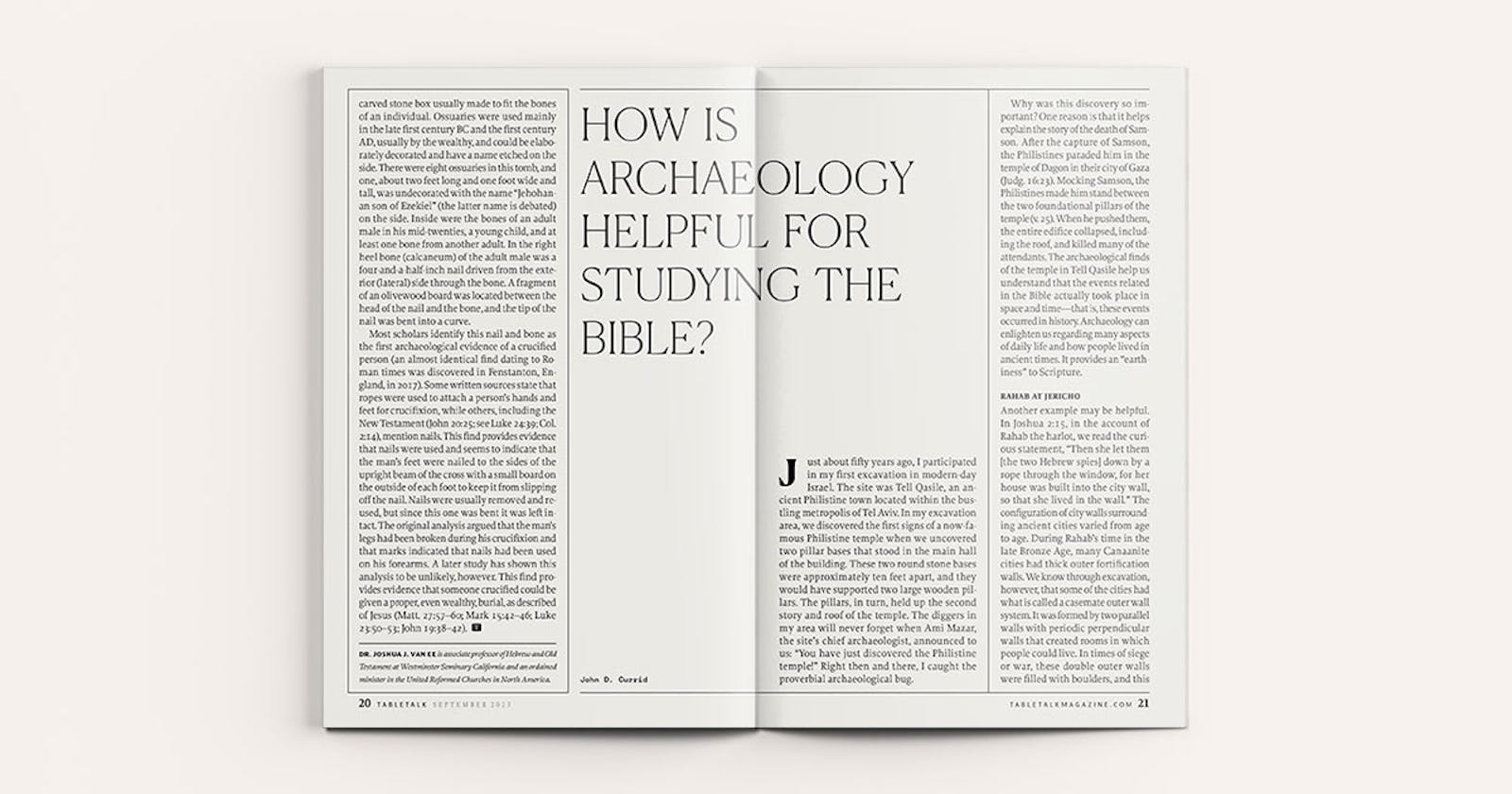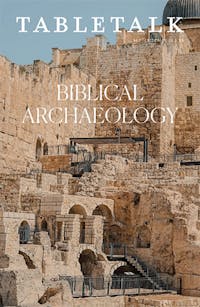
Request your free, three-month trial to Tabletalk magazine. You’ll receive the print issue monthly and gain immediate digital access to decades of archives. This trial is risk-free. No credit card required.
Try Tabletalk NowAlready receive Tabletalk magazine every month?
Verify your email address to gain unlimited access.
Just about fifty years ago, I participated in my first excavation in modern-day Israel. The site was Tell Qasile, an ancient Philistine town located within the bustling metropolis of Tel Aviv. In my excavation area, we discovered the first signs of a now-famous Philistine temple when we uncovered two pillar bases that stood in the main hall of the building. These two round stone bases were approximately ten feet apart, and they would have supported two large wooden pillars. The pillars, in turn, held up the second story and roof of the temple. The diggers in my area will never forget when Ami Mazar, the site’s chief archaeologist, announced to us: “You have just discovered the Philistine temple!” Right then and there, I caught the proverbial archaeological bug.
Why was this discovery so important? One reason is that it helps explain the story of the death of Samson. After the capture of Samson, the Philistines paraded him in the temple of Dagon in their city of Gaza (Judg. 16:23). Mocking Samson, the Philistines made him stand between the two foundational pillars of the temple (v. 25). When he pushed them, the entire edifice collapsed, including the roof, and killed many of the attendants. The archaeological finds of the temple in Tell Qasile help us understand that the events related in the Bible actually took place in space and time—that is, these events occurred in history. Archaeology can enlighten us regarding many aspects of daily life and how people lived in ancient times. It provides an “earthiness” to Scripture.
rahab at jericho
Another example may be helpful. In Joshua 2:15, in the account of Rahab the harlot, we read the curious statement, “Then she let them [the two Hebrew spies] down by a rope through the window, for her house was built into the city wall, so that she lived in the wall.” The configuration of city walls surrounding ancient cities varied from age to age. During Rahab’s time in the late Bronze Age, many Canaanite cities had thick outer fortification walls. We know through excavation, however, that some of the cities had what is called a casemate outer wall system. It was formed by two parallel walls with periodic perpendicular walls that created rooms in which people could live. In times of siege or war, these double outer walls were filled with boulders, and this would make the outer wall of the city stronger and thicker. Thus, Rahab, just as the book of Joshua says, could indeed live “in the wall” of the city of Jericho.
Earlier in the story of Rahab, she is pictured as hiding the two Hebrew spies on the roof of her house under stalks of flax that she had laid down on the roof. That is curious. But archaeologists have uncovered many houses from this time that have staircases leading to a roof. As is done today in numerous villages in Israel, the roof in ancient times was used for drying foodstuffs in the sun. What Rahab had on her roof was common for the day, and it would not have raised suspicion from the authorities. It would have been a perfect place to hide the Israelite spies, and thus they went undetected.
The weight of archaeological research is that it deals with the very physical nature of things and that it is therefore grounded in the realia (real things) of what happened in biblical times. We live in an age, however, in which history is typically seen as irrelevant, as meaningless, and as having little application to modern living. Common thinking today is ahistorical, in which scholars argue that there is no history that reflects truth and reality. Thus, many people today believe that history may be rewritten to suit one’s own agenda and purposes. Archaeology is a sword in the battle against ahistoricism. It truly demonstrates the “earthiness” of the Scriptures and how the episodes of the Bible occurred in time, place, and history. History is a pillar of Christian thought. God is the God of history: He created history, and time is moving historically from creation to consummation. Creation- fall-redemption-glorification is both a theological and historical construction and movement.
“pop” archaeology
Tried-and-true archaeological study of the Bible also helps us become informed, literate, and mature in our understanding of Scripture. It fortifies us against falling prey to movements such as “pop” archaeology, which receives lots of press for announcing staggering discoveries—such as the ark of the covenant (with blood still on it), or Egyptian chariot wheels in the Red Sea, or Noah’s house, or the stone tablets of the Ten Commandments. The purported stunning find has a long history in the church. For example, in the early fourth century AD, Constantine’s mother, Helena, declared that she had discovered the “true cross” in Jerusalem; many others throughout church history have made the same claim. John Calvin had a strong response to these so-called discoveries:
So great a quantity of fragments of the true cross were scattered among the Christian churches in his time, that they would load a large ship; and that, whereas the original cross could be carried by one man, it would take three hundred men to support the weight of the existing fragments of it.
Most of the spectacular claims of “pop” archaeology have been debunked, and so the church needs to be educated not to fall for archaeological charlatans.
The truth is that we do not need to grasp for the spectacular find because archaeological research has provided us with many important finds that help us understand the Bible. Many of these discoveries are not well known by people in the church or in society in general. I want to consider two more recent finds that have truly illuminated our understanding of Scripture and that help set the Bible in its proper historical setting.
ivory comb from lachish
In the year 2016, excavators at the biblical site of Lachish in the foothills of Israel discovered an ivory comb with an inscription on it. The comb was made of elephant ivory. It was a valuable piece in the ancient world because there were no elephants in the land at that time, and thus the piece must have been imported, perhaps from Egypt, where such combs are well known. The comb had teeth on both elongated sides. One side was for untangling knots in a person’s hair, and the other side was used to remove head lice and their eggs from the hair. Archaeologists were able to determine the comb’s purpose using microscopic tests that revealed remains of head lice still on the comb. The carved inscription also testifies to the comb’s use. The inscription is a mere seven words with a total of seventeen letters written in the Canaanite language, saying, “May this tusk root out the lice of the hair and the beard.”

The archaeologists at Lachish determined that the ivory comb and its inscription date to the Middle Bronze II period, which is between 1700 and 1550 BC. This date is several hundred years before the Israelite conquest of the land of Canaan. The dating is important because until the comb’s discovery, no Canaanite or Hebrew inscription had been found in the land that could be dated before the thirteenth century BC. Thus, this inscription predates any other inscriptional material in these languages in Canaan by a few hundred years.
Why is an inscribed ivory comb such a critical find? Often people have argued that Moses could not have written the Pentateuch in the second millennium BC because the Hebrew language had not yet come into existence. The Hebrew language is similar to the Canaanite language, however; in fact, when I translated the inscription on the ivory comb from Lachish, I was readily able to read it because much of the Canaanite vocabulary on the piece is the same as biblical Hebrew vocabulary. Consequently, writing that is close in form to the Hebrew that Moses would use was in the land of Canaan at least three centuries before Moses would have written the Pentateuch.
royal inscription of king hezekiah
In 2007, archaeologists were excavating in the area of a pool near the Gihon Spring in Jerusalem, and they discovered a limestone plaque from the eighth century BC. It is a palm-sized tablet (5.3 by 3.8 inches) that contains two lines of writing in Paleo-Hebrew letters or Old Hebrew script. The inscription has only recently been translated because several of the Hebrew letters are illegible. Translators believe that the first line contains the name of the Judahite king Hezekiah and that a word in the second line means “pool.” One translator, in fact, believes that the full inscription would read, “Hezekiah made the pool in Jerusalem.” We must wait for further clarity in regard to this inscription, but it does remind one of 2 Kings 20:20, which says, “The rest of the deeds of Hezekiah and all his might and how he made the pool and the conduit and brought water into the city [Jerusalem], are they not written in the Book of the Chronicles of the Kings of Judah?” (emphasis added).
It may be that the Hezekiah stone was part of a monumental inscription that would have been on the outside of a public building next to the pool at Gihon. If so, this would be the first royal inscription of a Judahite king yet discovered.
the body of moses
When I was a Ph.D. student in archaeology, my advisor came to me one day and said that a donor had presented a proposal to him. The donor wanted to fully fund an expedition to Moab to find the bones of Moses, who had been buried there before the Israelites crossed into the land of promise. My advisor said that he immediately thought of me to lead the expedition because I held a high view of the Bible. I turned down the offer. Deuteronomy 34:5–6 says, “So Moses the servant of the Lord died there in the land of Moab . . . opposite Beth-peor; but no one knows the place of his burial to this day.” I figured that if the Israelites had no idea where Moses was buried, then I had no chance at all of discovering his grave. The reality is that we need not grasp for the sensational or the spectacular find, but we need to depend on tried-and-true archaeological work to reveal ruins and finds that can help illuminate and underscore the “earthiness” of the Scriptures.
